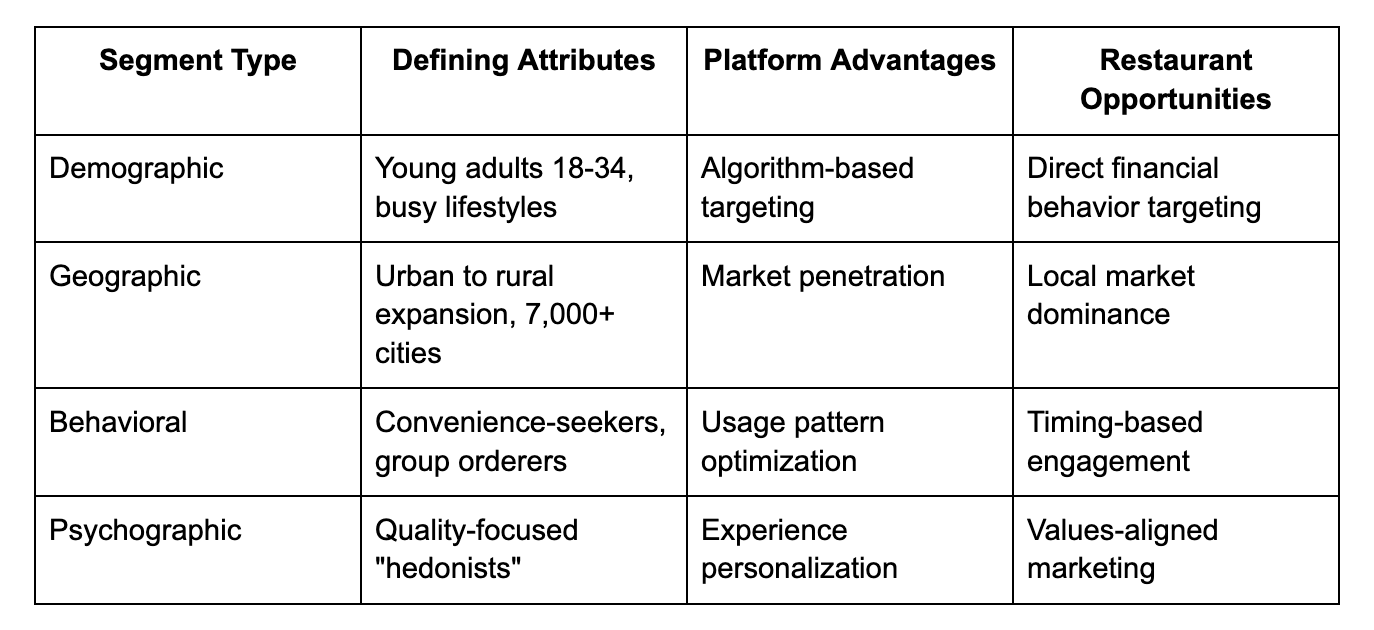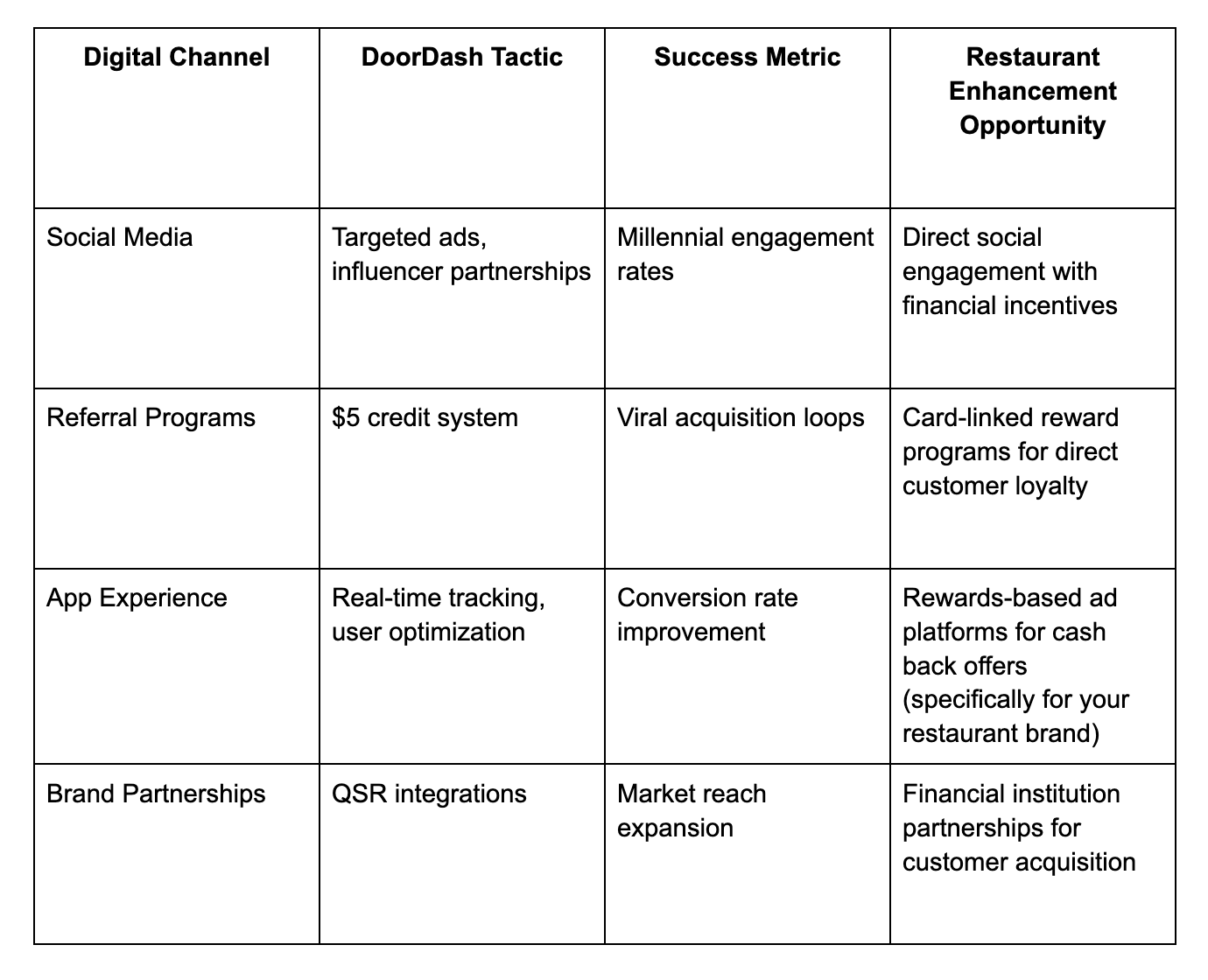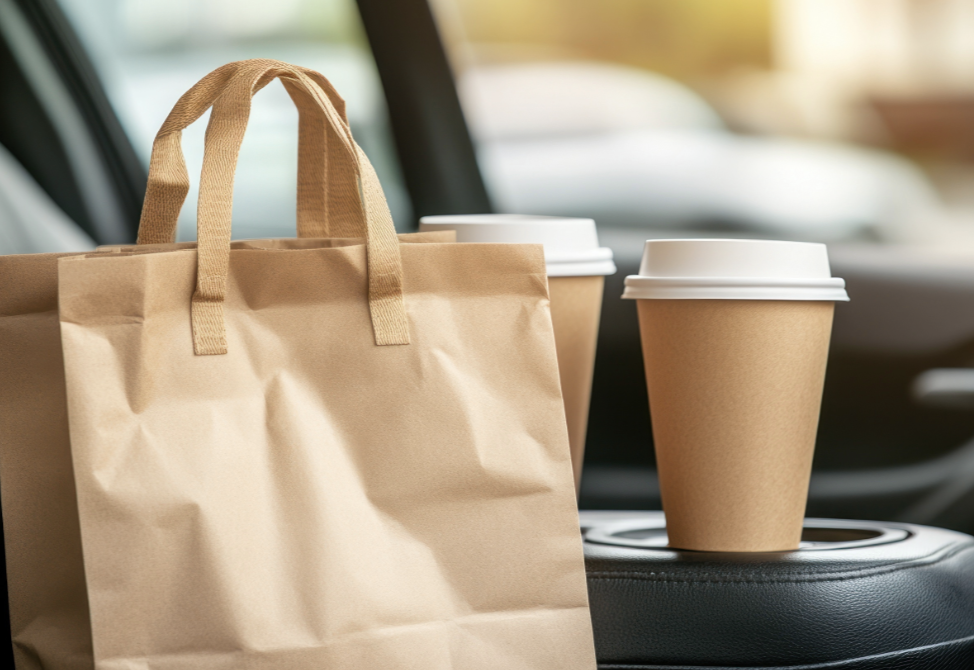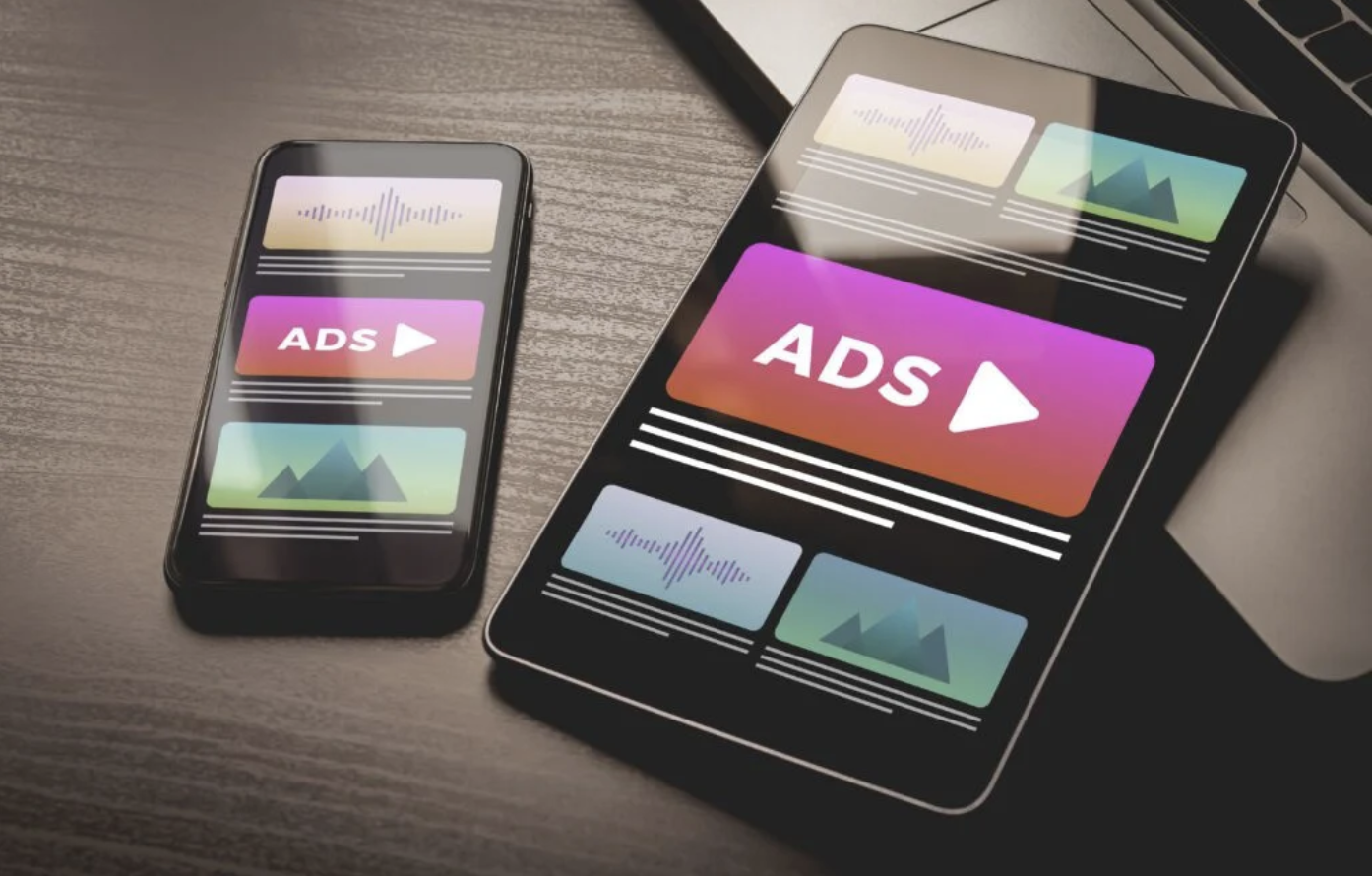Delivery is a margin-tight business. Order costs fluctuate, driver supply changes hourly, and customer loyalty can vanish with a single cold meal. Yet DoorDash continues to expand through precision targeting, constant product iteration, and a deep understanding of what diners, drivers, and restaurants value most.
The platform reaches thousands of cities across the United States, Canada, Australia, and New Zealand. And it holds 67% of the U.S. food delivery market share as of March 2024. That dominance didn’t happen by accident.
Below, we break down how DoorDash built its marketing machine and how quick serve restaurants can win in and out of the DoorDash platform.
Target Market Mastery: DoorDash’s Precision Audience Segmentation Strategy
DoorDash’s marketing strategy works because the company knows exactly who orders and why.
34% of DoorDash users are between 18 and 24 years old. Another 30% are between 25 and 34. That makes roughly two-thirds of its audience young diners, consumers who grew up expecting immediacy, personalization, and mobile-first experiences — precisely what DoorDash aims to deliver.
Generational and Geographic Focus
DoorDash built dominance not just in major cities but in overlooked suburbs and smaller towns. The company operates in 7,000 + cities, but roughly 37% of DoorDash users in the US were in low-income communities, and another 30% were located in rural communities. By targeting suburban families and mid-size metros early, DoorDash captured growth pockets that competitors ignored.
That doesn’t mean they don’t have a presence in major cities. In fact, The Ride Share Guy, a ride share influencer, ranked San Francisco, CA, Houston, TX, Dallas, TX, Phoenix, AZ, and Philadelphia, PA as some of the top places to be a Dasher because of the enormous market share they hold.
DoorDash also segments users by lifestyle as much as location, forming different campaigns and offers for:
- Busy professionals who trade time for convenience.
- Families relying on easy group orders.
- “Food explorers” who seek novelty and premium experiences.
- People who treat delivery as a reward for a hard day at work or to cater a social event.
Meeting people where they are — physically and mentally — has given the brand a significant edge over competitors.
Restaurant Takeaway
While its geographic and demographic segmentation strategy fuels DoorDash’s reach, it can leave restaurants dependent on algorithmic visibility.
High competition from inside the app means not every partner gets equal exposure. Quick serve restaurants can complement DoorDash campaigns with other forms of digital marketing, like cash back offers.
Giving diners cash back for making their first order can push them to try your food for dinner (and hopefully fall in love with it). Rewarding them for repeat orders can make them a loyal customer.

Innovation-Driven Growth: Product Development and Market Gap Strategy Analysis
In 2012, four Stanford students — Tony Xu, Stanley Tang, Andy Fang, and Evan Moore — interviewed local restaurant owners in Palo Alto and discovered that most lacked delivery options. One local macaroon shop had to cancel a bunch of delivery orders because they didn’t have enough staff to fulfill them.
The four set out to close that gap and launched PaloAltoDelivery.com in 2013.
From Startup to Platform
Fast-forward a little over a decade, and that early empathy turned into a full commerce ecosystem. DoorDash scaled methodically, city by city, state by state, until it reached all 50 US states and several international markets. And, as we mentioned earlier, rather than overextending in major metros, it focused on suburban and smaller urban areas where competition was lower and household delivery frequency was higher.
That same mindset (spotting and filling gaps) shaped its next phase of growth. DoorDash didn’t stop at restaurants. It expanded into alcohol delivery, grocery partnerships with Walmart, and convenience stores, all fueled by the surge in demand during COVID-19. Each move kept DoorDash ahead of changing consumer habits and reinforced its position as the default app for everyday needs.
Today, DoorDash’s Commerce Platform gives restaurants loyalty tools, marketing dashboards, and online-ordering integration, including features like:
- A free branded website and commission-free* online ordering
- Automated emails designed for conversion
- A branded mobile app
- Customizable marketing tools
In 2025, DoorDash spent $1.2 billion acquiring SevenRooms to support in-store dining and reservations. At the same time, it’s making delivery easier and faster with new delivery robots that operate on roads, bike paths, through parking lots, and up driveways, plus drones that can move food faster from point A to point B. That move signals how the brand sees itself now: not a delivery app, but a restaurant-growth engine.
Restaurants choose from 15%, 25%, or 30% service tiers depending on their need for visibility, logistics, and marketing support (DoorDash Newsroom).
Restaurant Takeaway
Obviously, restaurants aren’t building an ecommerce engine. But there are things to learn from DoorDash’s journey:
- Identify customer friction and fix it, through better tech, faster service, or easier payment experiences.
- Look for underserved audiences. Many local restaurants still overlook suburban families and late-night professionals who order multiple times a week.
- Build repeat behavior, not just first-time orders. Loyalty programs, seasonal events, and interactive social content can all drive frequency.
- Use tech as a loyalty engine. Cash back offer platforms, for example, give diners real value for eating at your restaurant — and give you first-party transaction data that reveals where else your customers spend. That data helps you form personalized marketing campaigns and relevant cross-brand partnerships.
Digital Marketing Excellence: Performance-Driven Customer Acquisition Tactics
DoorDash’s digital marketing engine combines targeted social ads, in-app personalization, and retail media to attract new users and keep existing ones ordering.
Paid Social
DoorDash’s largest acquisition driver is its social media. It runs targeted Facebook and Instagram campaigns aimed at Millennials and Gen Z, the same cohorts that dominate order volume.
Instagram’s ad tools let DoorDash match promotions to specific times of day or year: late-night cravings, college finals, big game weekends. Ads often spotlight local favorites or limited-time deals, urgency that gets people to spend on delivery. And authentic content from small influencers sharing real orders and experiences gets people thinking about delivery.
In-App Personalization
DoorDash uses browsing and order history to surface relevant restaurants and time-of-day offers that fit each customer’s habits. Restaurant partners can align their own promotions with these same signals to appear in front of the most active users.
DoorDash has also built several mechanisms into its native app and Dashpass subscription to keep customers buying, like $5 credits for referrers and friends and BOGO and DD Perks promos for first-order incentives.
Expanding the Ad Network
In 2024, DoorDash acquired adtech firm Symbiosys, building out its retail media network for automated, performance-based ad campaigns. The platform now sells sponsored listings and display placements both on and off DoorDash, giving brands measurable reach across web, app, and partner sites.
Strategic Partnerships
DoorDash also has national partnerships with QSR giants McDonald’s, Wendy’s, and Burger King, connecting its delivery experience to brands customers already trust.
Restaurant Takeaway
Restaurants can mirror DoorDash’s digital strength by diversifying their own acquisition stack. Rewards platforms link purchases to email and push notifications about cash back offers, giving you a clearer picture of attribution. Commerce media networks like Kard can even share broader spend data, showing how much market share you have compared to competitors and other stores that your customers shop at for a 360-degree view into how your audience spends.

Merchant Acquisition Strategy: Platform Growth Through Restaurant Partner Success
DoorDash’s growth depends on restaurants winning, and it’s got its merchant onboarding process down to a science. Listing setup, menu upload, and delivery activation only take a few hours. Once that’s done, a dedicated merchant dashboard surfaces sales trends, promo performance, and operational metrics so owners can pivot to act on any changes or trends they’re seeing (DoorDash for Merchants).
During new-city launches, DoorDash recruits local restaurants early to guarantee selection breadth, a tactic that builds immediate user trust.
Restaurant takeaway
The biggest advantage in partnering with DoorDash lies in the platform’s operational infrastructure:
- Integrated POS and inventory systems.
- Real-time support for order management.
- Access to demand data that they couldn’t collect alone.
Still, restaurants compete for in-app rank and pay commissions tied to visibility. Savvier operators treat DoorDash as just one of many distribution channels and build direct customer funnels through loyalty programs, cash back offers, or local advertising that drives diners back to owned channels.
Loyalty and Retention Innovation: Subscription and Rewards Strategy Analysis
DoorDash keeps users returning through programs that turn convenience into a habit.
DashPass: The Subscription Anchor
We briefly mentioned DashPass above, but it’s worth bringing up again — it’s that valuable a channel. DashPass offers unlimited free delivery on $12+ orders along with exclusive deals and seasonal perks.
The program not only gives DoorDash predictable recurring revenue, but subscribers tend to order more often and spend more per order, boosting overall platform unit economics.
Rewards and Engagement
DoorDash layers personalized discounts and limited-time perks to keep frequency high. DD Perks and seasonal promotions gamify loyalty through progress badges and achievement milestones. Referral programs blur the line between acquisition and retention by rewarding both giver and receiver.
Restaurant Opportunity
Being on the DoorDash platform gives your brand a lot of visibility, but not necessarily loyalty. In other words, diners might keep ordering through DoorDash, but not always from your restaurants. Creating your own rewards or cash back experiences helps build recognition for your brand, specifically.
Kard’s platform, for instance, connects rewards to customer credit or debit cards, giving diners automatic cash back tied to actual purchases. You set how much cash back, and the terms — for specific menu items, location-based offers, repeat rewards. Plus, you gain first-party transaction data and can trace offer usage to push notifications and emails to help refine your copy and messaging for conversion.
Brand Differentiation Strategy: Market Positioning and Competitive Advantage Development
Much of DoorDash’s marketing strength lies in how consistently it connects technology, service, and community. Every interaction, from the way the app looks to the way drivers communicate, reinforces their brand.
- Consistent messaging. From app design to driver uniforms, every DoorDash interaction reinforces accessibility and control. Their tone — across the app, SMS messages, their website, their ads — is friendly, fast, and helpful, conveying a sense of reliability and ease.
- Community emphasis. DoorDash positions itself as a partner to local economies, spotlighting small businesses in ad campaigns and community grants. Its Main Street Strong initiative during COVID-19 provided financial support and marketing boosts for struggling restaurants.
- Local Storytelling. The company uses regional campaigns, from Chicago pizza challenges to Austin BBQ spotlights to associate DoorDash with neighborhood pride, not just delivery.
Restaurant Takeaway
Partnering with DoorDash aligns your QSR brand with a positive, helpful, sustainable message. But you need to develop your own branding and marketing strategies, too.
QSRs that build direct communication channels, community ties, and distinctive messaging reduce dependence on DoorDash algorithms and pricing. Consistency across on-platform and off-platform experiences (menu, packaging, voice, loyalty) strengthens recognition long after an order leaves the app.
Performance Analytics and Strategic Measurement: Data-Driven Growth Optimization
Every DoorDash campaign, promotion, and partnership is tied to measurable performance.
Real-Time Tracking
Merchant and consumer dashboards show live results on order trends, delivery status, and customer feedback. Restaurants can see which menu items perform best, how promo codes affect cart size, and when demand spikes by hour or neighborhood. This real-time visibility helps operators adjust staffing, inventory, and marketing before issues compound.
AI and Automation
DoorDash integrates AI analytics and POS data to track menu performance, customer satisfaction, and productivity in real time. These insights allow restaurants to act fast — optimizing pricing, adjusting menus, or launching micro-promotions when certain metrics dip.
What Restaurants Can Learn From DoorDash — And How They Can Elevate Their Marketing Even More
DoorDash built its dominance on clear messaging, precise targeting, frictionless UX, and data that connects every decision back to growth. Today’s growing quick serve restaurants can take a few pages out of that playbook for their own marketing strategy:
- Use data to know who your customers are, when they order, and what drives them to reorder.
- Invest in retention. A loyal diner is worth a whole lot more than a bunch of first-time orderers.
- Design experiences that feel local and personal. DoorDash markets at scale, but you can market with community insight.
But you don’t have to copy everything DoorDash does. And DoorDash certainly shouldn’t be your only marketing strategy.
If you’re ready to turn your DoorDash presence into owned growth, Kard can help. Set your own cash back offer structure, root campaigns in verified transactions from 61M+ users, and pay only when an offer is redeemed.
Want to see how it works? Schedule a demo today.
FAQs on DoorDash marketing strategy
What marketing strategy does DoorDash use?
DoorDash uses a data-driven, multi-segment approach - targeting Gen Z, Millennials, and busy parents by leveraging first-party data, behavioral insights, and regional opportunities across 7,000+ cities for tailored campaigns that boost real engagement and ROI.
What is DoorDash’s target market?
DoorDash's primary target market includes young adults aged 18-34, busy professionals, families, and “hedonists” seeking quality and convenience - spread across metro, suburban, and rural areas in the US, Canada, Australia, and Japan.
How does DoorDash segment its audience?
DoorDash segments its audience by demographic (age, lifestyle), geographic (city, suburb, rural), behavioral (order patterns, group size), and psychographic traits (quality-focused, social seekers, experience-driven eaters).
How does DoorDash differentiate itself from competitors like Uber Eats or Grubhub?
DoorDash differentiates itself through suburban/rural expansion, tech-enabled features, exclusive partnerships, and a user-focused experience - delivering value beyond city centers and continuously launching new services like DashPass and grocery delivery.
What are some DoorDash product innovation milestones?
Key milestones include launching in underserved local markets, rapid US and international expansion, grocery/alcohol delivery, and cross-category partnerships (e.g., Walmart), supporting a flexible and broad platform ecosystem.
How does DoorDash measure marketing performance?
Marketing performance is measured by order volume, conversion rate, user growth, subscription sign-ups, and campaign entries - using advanced dashboards that track real-time results and attribution down to the transaction.
What digital promotion tactics does DoorDash use?
DoorDash combines social ads, referral bonuses, influencer partnerships, targeted offers (like BOGO and “DD Perks”), and in-app advertising to engage and convert high-intent users, with measurable results visible in campaign analytics.
How does DoorDash partner with merchants and restaurants?
DoorDash partners with restaurants and retailers by providing a streamlined onboarding process, campaign dashboards, strategic co-marketing initiatives, and operational insights to help partners optimize listings and expand reach.
What merchant acquisition techniques drive DoorDash’s growth?
Top techniques include local onboarding campaigns, integration with national and regional QSR brands, and tech-driven promotion tools that make it easy for merchants to join and scale within the DoorDash marketplace.
How does DoorDash retain users and drive loyalty?
DoorDash drives loyalty with DashPass subscriptions, personalized offers, monthly perks, and gamified referral incentives - making reward-based engagement and exclusive deals central to repeat customer retention.
How does DoorDash sustain brand leadership and market visibility?
DoorDash sustains leadership with tech-forward branding, community values, consistent national and local campaigns, and a focus on consumer experience that positions it as a trusted, accessible solution across diverse markets.
How does DoorDash use analytics in its marketing strategy?
DoorDash applies analytics to guide campaign targeting and creative, optimize partner performance, and adjust strategy in real time - linking every marketing decision to growth metrics and measurable customer impact.
What are the four main DoorDash audience segments?
- Gen Z foodies
- Millennials and young professionals
- Busy parents
- Suburban/rural convenience seekers
- Experience-driven and social eaters
What’s the best strategy for DoorDash marketing?
The best strategy centers on precision targeting, performance-based promotions, local market expansion, tech-driven rewards, and actionable measurement - delivering both broad reach and high ROAS across core customer segments.


